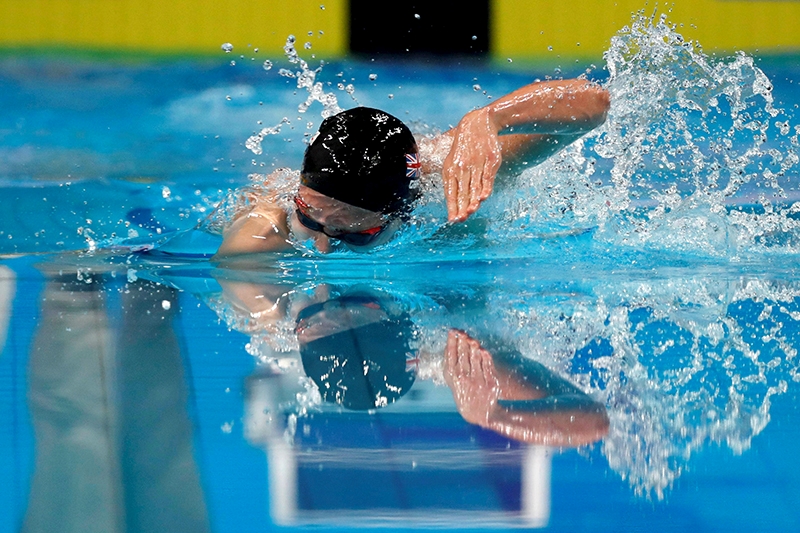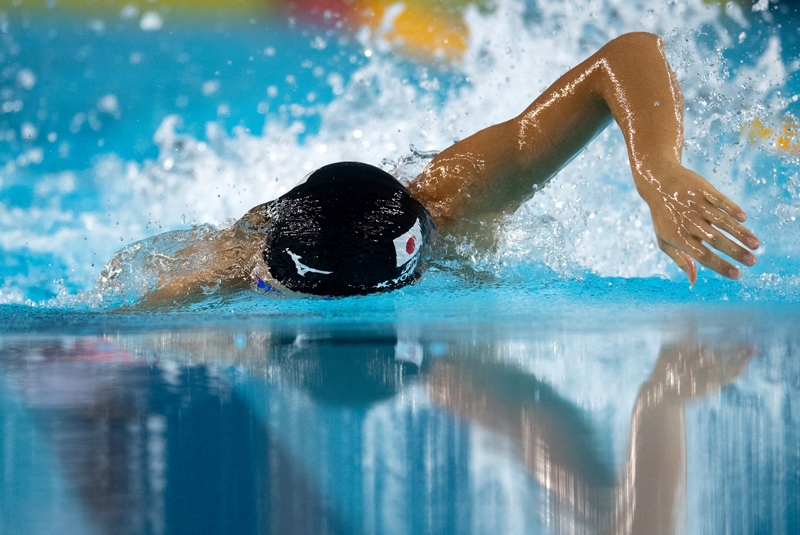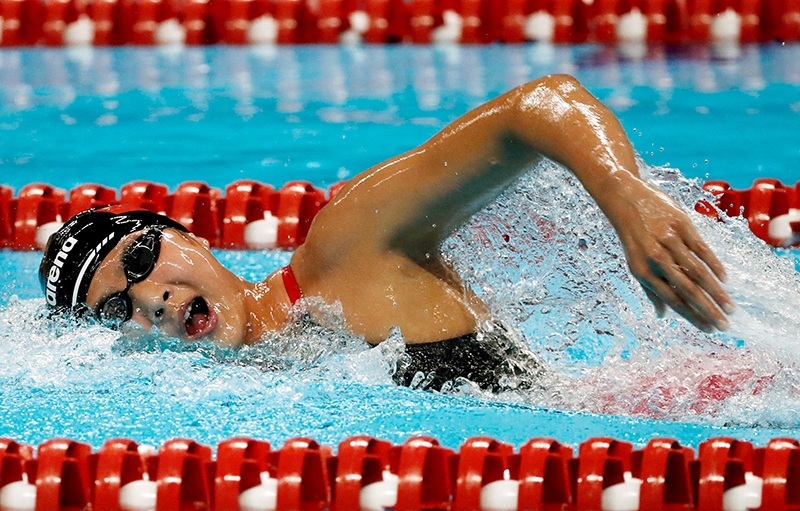You are viewing 1 of your 1 free articles. For unlimited access take a risk-free trial
Gliding to a new PB: perfect turns make for fast times

If you’ve got a swim or triathlon coming up where the swim leg is held in the pool, it’s worth thinking about maximising your efficiency in the turns. Andrew Hamilton looks at what the recent research says about this subject
When it comes to maximising efficiency through the water in a pool-based swim event or triathlon, swimming technique is only part of the story because after every 25 or 50m, you’ll need to turn, which involves a tumble, a push-off the wall and a glide back into the swimming action. Of these, it’s the glide that constitutes the lion’s share of the distance covered during a turn, and for that reason, gliding efficiently is a crucial part of fast pool swimming.Gliding position
Observations show that some swimmers prefer gliding in a lateral position (ie side on with one shoulder pointing down and other up) while other prefer to glide in a prone position (ie horizontal face-down position with shoulders parallel to the water surface. This begs the question of course of just which gliding position is best? With this in mind, Portuguese scientists spent time studying the effects of different gliding positions on drag and efficiency in swimming(1).In an extremely informative study, the effects of different body positions while moving through water were simulated using a technique called computational fluid dynamics (CFD) to determine which resulted in the lowest ‘drag coefficient’ – a measure of the drag forces that impede movement through a medium such as water. In order to create the CFD model, computer tomography scans of a human body of a male swimmer were undertaken. The swimmer was modelled as if he were gliding underwater in a streamlined position, at four different body positions:
- In the prone position;
- In a side (lateral) position with an absolute angle between the horizontal plane with the body coronal plane of 45° (in effect, halfway between lateral and prone);
- In a pure side position with 90° of rotation (ie shoulders perpendicular to the water surface);
- In the dorsal position (on the swimmer’s back).
The results showed that drag was lowest in the prone position followed by the side position with 45 degrees of rotation followed by pure side. The dorsal position produced the highest drag figures. In the side position with 45 degrees of rotation (position #2) the drag coefficient was increased by 0.29%, 0.15% and 0.01% at swimming speeds of 1.5, 2.0, and 2.5 m/s, respectively compared to the most efficient (ie prone) position. In the pure side position, drag was increased by 1.03%, 0.94% and 0.64% at each of the three swimming speeds while in the dorsal position, drag was increased by 2.21%, 1.42% and 0.96% for the three swimming speeds.
Gliding depth
Another question that arises is what depth under the water surface should a post-turn underwater swimming glide be to minimise drag? A 2012 study looked at exactly this issue by modelling the drag forces on a swimmer gliding in the prone position at depths of 0.25, 0.5, 0.75 and 1.0m and at speeds of between 1.5-2.5 meters/second(2). It found that regardless of speed, drag decreased with increasing depth, although after 0.75m values remained almost constant (see figure 1). The researchers therefore concluded that gliding at a depth of 0.75m under the surface was a good compromise for swimmers seeking maximising gliding efficiency.Figure 1: Drag force while gliding at 1.5m/s at 0.25, 0.5, 0.75 and 1.0m below the water surface(2)

The obvious question to ask at this point is why is drag lowered when swimming at 0.75m below the surface than swimming nearer to it? This is a particularly pertinent question when we know from previous research that gliding on the water surface elicits lower drag than when swimming below it(3). The reason is down to something called ‘wave drag’.
A swimming glide on the water surface elicits less drag as the frontal drag presented to the water is considerably reduced (part of the swimmer’s head and shoulders are above the watermline. However, when an underwater glide is made close to the surface, the movement forms waves at the surface, which causes an extra impediment to movement through the water due to pressure differences caused by the waves.
The fluid dynamics/physics behind this phenomenon is very complicated but the effect is well documented(4). This extra drag is called wave drag. The higher value of hydrodynamic drag at a depth of 0.25 m was the result of a glide made close to the surface, which contributed to the formation of waves at the surface, causing wave drag. Glide deeper however, and wave disturbances on the water surface (and hence wave drag) diminishes.
Wave drag contributes around 50 to 60% to total drag force, in elite swimmers, when swimming at the surface. As a rule of thumb, swimmers must be at a depth higher than 1.8 times the diameter of their chest to eliminate wave drag when gliding at a 0.9 m/s velocity. This depth increases to 2.8 times chest diameter for a gliding velocity of 2.0 metres per second. But once the glide depth is at or below 0.75m, wave drag is almost totally eliminated regardless of the swimmer’s dimensions and glide speed, making this a good figure to aim for!
Practical application
- *When gliding, always use the prone position. To also minimise drag, you should ensure your hands overlap, your head between your (extended) arms, feet are together with toes pointing in line with your legs;
- *Glide at around 0.75m depth. You will need practice to achieve this (it may also help to use a marker on the pool wall at that depth);
- *Don’t neglect practising the other parts of the turn (they are still important) and ensure your swimwear is as close fitting and streamlined as possible!
- Br J Sports Med. 2013; Jul;47(10):e3
- J Human Kinetics 2012; vol 33/2012, 55-62
- Sports Biomech, 2007; 6: 81-98
- J Biomech, 2006; 39: 664-671
Newsletter Sign Up
Testimonials
Dr. Alexandra Fandetti-Robin, Back & Body Chiropractic
Elspeth Cowell MSCh DpodM SRCh HCPC reg
William Hunter, Nuffield Health
Newsletter Sign Up
Coaches Testimonials
Dr. Alexandra Fandetti-Robin, Back & Body Chiropractic
Elspeth Cowell MSCh DpodM SRCh HCPC reg
William Hunter, Nuffield Health
Keep up with latest sports science research and apply it to maximize performance
Today you have the chance to join a group of athletes, and sports coaches/trainers who all have something special in common...
They use the latest research to improve performance for themselves and their clients - both athletes and sports teams - with help from global specialists in the fields of sports science, sports medicine and sports psychology.
They do this by reading Sports Performance Bulletin, an easy-to-digest but serious-minded journal dedicated to high performance sports. SPB offers a wealth of information and insight into the latest research, in an easily-accessible and understood format, along with a wealth of practical recommendations.
*includes 3 coaching manuals
Get Inspired
All the latest techniques and approaches
Sports Performance Bulletin helps dedicated endurance athletes improve their performance. Sense-checking the latest sports science research, and sourcing evidence and case studies to support findings, Sports Performance Bulletin turns proven insights into easily digestible practical advice. Supporting athletes, coaches and professionals who wish to ensure their guidance and programmes are kept right up to date and based on credible science.













